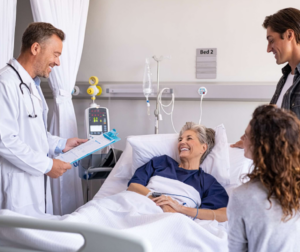
The Importance of Continuous Monitoring in Patient Lives
We had the chance to speak with Dr. Arun V, who heads the department of Anesthesia, Critical Care & Pain Management at Aster CMI, to understand the new trends in this space and how continuous monitoring is impacting the patient journey.
What kind of patients do you work with?
My patient population falls in two categories, a) High-risk surgeries and b) High-risk patients for simpler surgeries. Typically, patients I see for anesthesia need a liver or renal transplantation, GI surgery, or orthopedics and surgical oncology procedures. Most of these patients undergo high-risk procedures which usually last about 8-10 hours per surgery. A sizeable number of these patients undergo a significant amount of blood loss and fluid shift and need intensive care during or after the surgery, in their recovery phase. A majority of these patients are elderly patients or have multiple co-morbidities such as hypertension, diabetes, and other similar concerns. Additionally, they might have malignancy and may need to undergo oncology surgeries. Simultaneously, I also get involved with pediatric patients, neonates, patients who have airway issue, or patients with difficult intubations.
How do you currently handle critical patients and any patterns that you observe in such patients?
We are noticing a shift in the type of patients that we are seeing. Previously, we would treat patients with infections and basic surgeries such as hernias, but now we are seeing a lot of high-risk patients who need further intense monitoring during their recovery. In the past, a lot of these patients were denied surgeries due to the risks involved such as blood loss, co-morbidity concerns, or the duration of surgery. However, now with anesthesia becoming safer and more tailored for individual patients, a lot of them are being offered surgeries. We usually encounter critical patients primarily due to their underlying conditions and due to the type of surgeries they undergo. Earlier, neuro surgeries, cardio-thoracic surgeries were considered critical, however, now with transplants growing, especially liver transplants which is currently witnessing an upward trend in India, these patients are slightly challenging primarily because of other existing medical conditions. Additionally, people developing various types of cancer these days and with improved quality of life are coming into hospitals to get critical surgeries done. Therefore, we notice a shift in the type of patients we treat. Previously, we would treat patients with a lot of infections and straight forward surgeries such as hernias but now we are seeing a lot of high-risk patients who need intense monitoring during their recovery.
Not only are we doing more complex surgeries, but we are looking at earlier discharges and most importantly earlier recoveries. Because of rising medical costs patients are also keen on earlier discharges. It is a combination of the financial and the medical aspect of the situation that is making post-operative recovery more challenging and promoting the idea of patients being monitored at home. This gives an edge to patients who are happier being shifted to the ward and being discharged home earlier where they recover amongst their family members. It also eases the pressure on the system and the family.
Have you noticed any positive clinical impact if the patients are discharged earlier?
In the past, there have been many challenges as to when should we start feeding the patients, when can they take medications orally, or how quickly they can be mobilized. We have now come into an era of Enhance Recovery After Surgery (ERAS) where a lot of patients are being mobilized faster and going back to the ward or even released home earlier. Previously, recovery after surgeries which used to take a week’s time has been cut down to 2-3 days’ time. As a result, we are seeing an increased satisfaction in patients as they are getting discharged earlier, and able to recover at home amongst their family members. Previously, recovery after surgeries which used to take a week’s time has been cut down to 2-3 days’ time. A lot of patients are being mobilized faster and going back to the ward earlier. Patients are also happier going back to the ward earlier rather than staying in the ICU or in the hospital for too long. Under these circumstances, we need options to monitor the patients during the recovery phase at a higher level. ERAS, in itself is good for these patients, but it is equally important to maintain safety during early recovery.
In a typical scenario, how often are patient vital signs monitored?
Previously, all high-risk patients or elderly patients would be shifted to ICU. They would have been monitored in an ICU set-up for 24-48hrs and then moved to the ward. However, the scenario is slightly different now, in the times of ERAS, moving patients to an ICU set-up may not be the best of option until there is a very strong medical reason to do so. We have observed that recovery is better when the patient is in familiar surrounding with family members in the ward and mobilizing them in the ward itself. If we are to shift focus from moving patients from ICU to ward, then we will have to look at options on how to continuously monitor these patients in the ward. Vital signs such as Heart Rate, Blood Pressure, Oxygen Levels are essential to monitor to detect any early signs of complications and therefore extremely essential during recovery. These factors are useful for us to determine if the patients can stay in the ward or if predetermined clinical conditions are detected, we need to shift them to ICU, if need be. Just because you are monitoring does not mean you will not shift the patient to the ICU but rather you can shift them earlier when it is still safer for them rather than waiting for signs of deterioration. A proactive approach rather than a reactive approach.
Traditionally, nurses take on the task of vital signs monitoring but in the present day and scenario nursing shortages are pushing for alternative solutions to provide additional clinical efficiency. If we push the envelope slightly further, we would also consider remotely monitoring these monitors itself so that one can have a cohort of patients and in turn remotely monitor the patients. A single person can monitor around 10-12 patients constantly. Remote monitoring ensures that all patients who have undergone surgeries are provided regular monitoring. This will improve patient safety over time and reduce patient time in ICU by intervening proactively.
Usually, a nurse goes around in the ward every 2-3 hours, now if you have monitoring devices, the monitor will alarm the nurses whenever a situation arises and if you can monitor these bedside monitors remotely which enables a nurse to monitor 20 patients at one go rather than walk around each ward to physically check the bedside monitors. This set-up gives the nurses more time towards other patient centric activities such as administering drugs, mobilizing the patients, so on and so forth.
Any other noteworthy healthcare innovations which have contributed to this are of vital signs monitoring in the recent past?
Over the last few decades anaesthesia has become significantly safer as we constantly monitor the patient’s vital signs. Monitoring a patients’ vital signs have improved anaesthesia care and has allowed for the expansion of care beyond the hospital. Most patients now have become comfortable wearing sensors; Smart watches or rings that can detect vital signs or even ECGs. Majority of the youngsters nowadays wear smartwatches which can detect their oxygen saturation levels. Recently, smartwatches are also equipped to monitor ECGs. We are now pushing monitoring vital signs into the general masses and outside a hospital set-up.
Any concluding thoughts?
Recently, a lot of monitoring technologies has been developed only in the last few decades. There are few minimally invasive monitoring technologies available today. For instance, glucose monitoring, which is slightly invasive, however over time monitoring devices will become more wearable and reliable. Currently, monitors such as BP cuff, ECG are slightly bulky as they are dependent on outdated technologies developed over the last few decades rather than the last few years. However, present-day monitoring devices are evolving to smaller, portable, and more wearable solutions, such as oxygen sensors. These things will shape the future for remote monitoring and vital signs monitoring in general will notice a shift towards technology-based monitoring rather than nursing-based monitoring.



